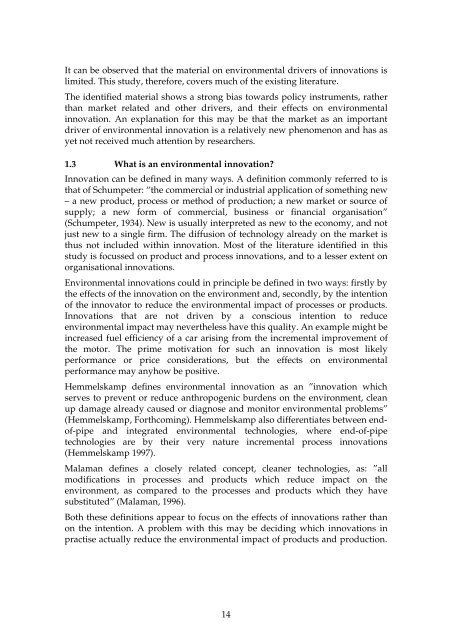Drivers of environmental innovation - Vinnova
Drivers of environmental innovation - Vinnova
Drivers of environmental innovation - Vinnova
Create successful ePaper yourself
Turn your PDF publications into a flip-book with our unique Google optimized e-Paper software.
It can be observed that the material on <strong>environmental</strong> drivers <strong>of</strong> <strong>innovation</strong>s is<br />
limited. This study, therefore, covers much <strong>of</strong> the existing literature.<br />
The identified material shows a strong bias towards policy instruments, rather<br />
than market related and other drivers, and their effects on <strong>environmental</strong><br />
<strong>innovation</strong>. An explanation for this may be that the market as an important<br />
driver <strong>of</strong> <strong>environmental</strong> <strong>innovation</strong> is a relatively new phenomenon and has as<br />
yet not received much attention by researchers.<br />
1.3 What is an <strong>environmental</strong> <strong>innovation</strong>?<br />
Innovation can be defined in many ways. A definition commonly referred to is<br />
that <strong>of</strong> Schumpeter: “the commercial or industrial application <strong>of</strong> something new<br />
– a new product, process or method <strong>of</strong> production; a new market or source <strong>of</strong><br />
supply; a new form <strong>of</strong> commercial, business or financial organisation”<br />
(Schumpeter, 1934). New is usually interpreted as new to the economy, and not<br />
just new to a single firm. The diffusion <strong>of</strong> technology already on the market is<br />
thus not included within <strong>innovation</strong>. Most <strong>of</strong> the literature identified in this<br />
study is focussed on product and process <strong>innovation</strong>s, and to a lesser extent on<br />
organisational <strong>innovation</strong>s.<br />
Environmental <strong>innovation</strong>s could in principle be defined in two ways: firstly by<br />
the effects <strong>of</strong> the <strong>innovation</strong> on the environment and, secondly, by the intention<br />
<strong>of</strong> the innovator to reduce the <strong>environmental</strong> impact <strong>of</strong> processes or products.<br />
Innovations that are not driven by a conscious intention to reduce<br />
<strong>environmental</strong> impact may nevertheless have this quality. An example might be<br />
increased fuel efficiency <strong>of</strong> a car arising from the incremental improvement <strong>of</strong><br />
the motor. The prime motivation for such an <strong>innovation</strong> is most likely<br />
performance or price considerations, but the effects on <strong>environmental</strong><br />
performance may anyhow be positive.<br />
Hemmelskamp defines <strong>environmental</strong> <strong>innovation</strong> as an ”<strong>innovation</strong> which<br />
serves to prevent or reduce anthropogenic burdens on the environment, clean<br />
up damage already caused or diagnose and monitor <strong>environmental</strong> problems”<br />
(Hemmelskamp, Forthcoming). Hemmelskamp also differentiates between end<strong>of</strong>-pipe<br />
and integrated <strong>environmental</strong> technologies, where end-<strong>of</strong>-pipe<br />
technologies are by their very nature incremental process <strong>innovation</strong>s<br />
(Hemmelskamp 1997).<br />
Malaman defines a closely related concept, cleaner technologies, as: ”all<br />
modifications in processes and products which reduce impact on the<br />
environment, as compared to the processes and products which they have<br />
substituted” (Malaman, 1996).<br />
Both these definitions appear to focus on the effects <strong>of</strong> <strong>innovation</strong>s rather than<br />
on the intention. A problem with this may be deciding which <strong>innovation</strong>s in<br />
practise actually reduce the <strong>environmental</strong> impact <strong>of</strong> products and production.<br />
14

















